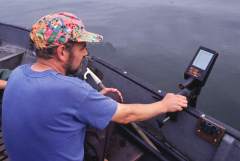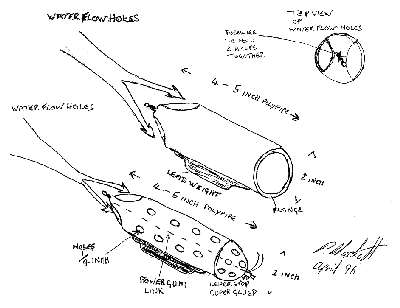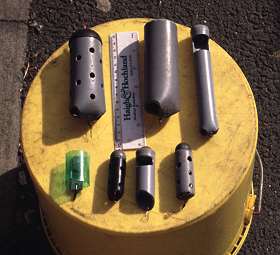Phil Hackett haslong been known as Mr Gadget due to his penchant for crazy and not socrazy inventions. Some have been so good they were nicked by wellknown tackle companies after they saw them. Some never saw the lightof day.
But you can’t faulta mad inventor who only a few short years ago went from being awindow-cleaner with no qualifications to gaining a degree inEnvironmental Studies, a Masters degree in Countryside Management andnow works as a lecturer in Further Education.
He now describeshimself as a madder than mad inventor due to the time he’s spent inacademia.
|
|
| |
His areas ofinterest within the Environmental discipline are primarily Ecology(terrestrial and aquatic environments) but extending into allenvironmental, health and social areas. He has carried out researchinto the progression of introduced fish stocks in a recovering riverafter long-term pollution.
Research urban parkbird populations and the links they have with British native trees.Researched the ecological biodiversity of several Manchester parks,and is currently researching (on going) roach populations in regardsto their potential life span. He was a consultant expert witnesspresenting evidence on ecology at a local public inquiry. Activelybeen involved (Hands on, in the dirt) in habitat improvements throughout the Manchester area.
Phil has campaignedon many issues locally over many years from the proposal toincinerate cattle carcasses that potentially had the BSE agent withinthem to local air pollution and health issues. He has activelyparticipated in the local campaign group arguing for increasedsustainable facilities and regeneration for the area. It is his firmbelief that local issues should be decided by the local people wholive there. Not by officers, councillors and/or council committeeswho live in leafy parts well removed from the problems faced by localpeople.
His fishinginterests are simple. He just enjoys whatever he’s fishing for,whatever the species. He’s fished for all species of coarse fish overthe years except one, the catfish. Of all the fish he’s caught onefish stands proud in his mind, a 10 lb 2 oz bream from an extremelydifficult Cheshire mere in the early eighties. It was his firstdouble and the campaign for that fish cost him two summers withoutseeing or setting a hook into a fish. He still can’t describe theelation he felt after netting it. Never since has he felt like thatabout any other fish that he’s caught.
How To Make Mega Feeders
This is how to make some mega feeders I invented some years ago. Thetop drawing is of a groundbait feeder the bottom a maggot dropper. Ioriginally designed the maggot dropper for roach when and old friend,the late Roger Harker, and myself were fishing Worthington Lakes inWigan.
|
|
| |
‘Lake’ is a misnomer as they were in fact reservoirs, which whenfull during the winter, were 40+ft deep. The problem we were havingwas that catapulted maggots took a long time to sink and tended tofetch the fish up in the water. As we wanted the fish on the bottom,a radical solution needed to be found.
To compound the problem we could only use loose feed, asgroundbaiting on the lakes was banned because they were drinkingwater reservoirs. To avoid breaking the rules, and so that we couldget feed down quickly to the bed, I developed the mega maggotdropper. These droppers allowed us to get a pint of maggots down inabout 8 casts. The groundbaiter was a natural progression of thedropper. This came about again because I was fishing a local deepreservoir at range, where the roach responded better to a loose-feedbed than they did to balls of groundbait on the bottom
My own opinion is much the same as Graham’s: it is much better ifyou have an evenly spread bed of feed rather than a bed of largeballs of groundbait in your swim. The fish are more likely to findthe hookbait before they get full off several balls of groundbait andthen sod off laughing at you! I guess the thinking behind it is muchlike the way free-range chickens feed, ie, picking up individual fooditems and moving on to the next.
I have subsequently used the method for bream and tench on acouple of waters and it works reasonably well. I even tried it on theriver for barbel and chub and caught fish.
The Groundbait Feeder
Take a six-inch length of 2 inch polypipe, cut two 60 degree anglesat one end, heat up the angles with a gas stove and bend them in sothat they meet, holding them in place until they set.
|
|
| |
There is some flattening of the tube when this is done but don’tworry about it, as it just makes the feeder more streamlined whenit’s retrieved. Put two small holes of at least 3mm diameter, 5mmeither side of the meeting point. Take some fuse wire and stitchthrough the holes several times, placing a large swivel on the secondand all other subsequent stitches.
I recommend that at least three stitches are needed for thisprocess, as there can be up to 4-6 oz of weight in the feeder whenfull.
To put a flange on the base of the groundbait feeder heat the baseup and rub on a flat surface, this turns the plastic down and over,making the flange. It helps to keep the groundbait in as it fliesthrough the air.
The feeder must have lead added to it because polypipe floats. Buyor make some lead strips, drill some holes in the pipe lengthways andinsert part of the lead strip through the holes. You need at least10mm on the inside of the pipe to bend over to keep the strip secure.The strip must also weigh at least













